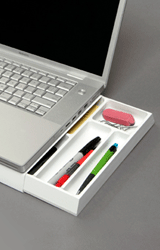

A sliding desk drawer that stores one's most important desk items beneath the laptop.
It is increasingly common for desks to be built without storage, leading people to clutter desk surfaces with pens, computer cords, and other items. Visual clutter is detrimental to mental focus so an alternative storage solution is needed.
Developed in conjunction with Prof. Bruce M. Tharp, the Italian company Danese Milano, and design office JODR.
Project Background
Danese Milano contacted the School of the Art Institute of Chicago to develop a series of products that would complement the lifestyles of young adults. In addition Danese Milano required that all designs be easy enough to fabricate in school facilities and mantain Danese Milano's characteristic minimal style.
A special class under Bruce Tharp was formed to create prototypes and proposals. Designs deemed the most commercially viable would be produced.
Research (click for indepth research)


















Research focused on how people organized or disorganized their desks and its impact how it influenced their productivity.
It was determined that in an increasing number of people work on desks with no drawers or alternate storage. No matter how organized someone may be, the desk often remains cluttered with desk objects such as pens, extra computer cords, emergency Advil, notecards / business cards, etc.
Many interviewees were disatisfied with existing organizers because the desk surface remained cluttered. Thus in the absence of a desk drawer, many wanted a new storage location that is convenient and unobtrusive.
Ideation
As stated above, many existing desk organizers compromise desk space or convenience. Drawers are excellent solutions but are not always included on a desk. Thus the most logical solution would be to develop a portable drawer. Since simplicity and minimalism are two of Danese Milano's hallmarks, it was determined the product would consist of a simple shell and sliding tray that sat under a laptop.






Prototyping
The initial design opened towards the user like a conventional desk drawer but this placed unwarranted strain on the wrist and the back of the tray was inaccessible unless pulled out all the way. It was an akward arrangement.
Both issues were resolved by changing the tray's direction from forward-and-back to side-to-side. The user instead pushes from the right side for the tray to open on the left and vice versa.
The next step was to determine the tray's compartment configuration. A variety of arrangements were lasercut and tested to fit the various objects that appear in desk spaces.
The resulting design placed small objects like pens to one side and large objects like iPods on the other. This design interfered the least with the computer mouse because the side with small objects does not have to be opened very far. A wood and steel prototype was produced to test the functionality of the design.
Final Model
The final design ultimately differed little from the prototype. The bent-steel external shell was given an angular profile, providing the appearance of a pedestal for one's laptop. A cheap and sturdy sawdust composite material was substituted for expensive wood that would be prone to warpage and breaking if handled improperly. The white color ensures that it complements its surroundings and its white interior makes the interred items easy to find and identify.
Credit
All project imagery here was produced by Mingli Chang for Danese Milano unless otherwise specified. All Flickr imagery belong to their respective owners and were only used to gather research data.















